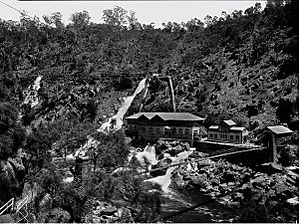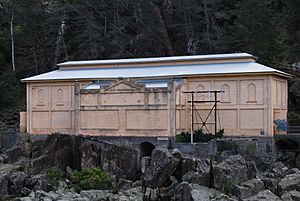Duck Reach Power Station facts for kids
Quick facts for kids Duck Reach Power Station |
|
|---|---|

Duck Reach Power Station c1930
|
|
| Country | Australia |
| Location | South Esk River, Tasmania |
| Coordinates | 41°27′33″S 147°6′40″E / 41.45917°S 147.11111°E |
| Status | Closed |
| Commission date | 1895 |
| Decommission date | 1955 |
| Owner(s) | Hydro Tasmania |
The Duck Reach Power Station was a very important place in Tasmania, Australia. It was the first power plant in the Southern Hemisphere that used hydro-electric power. This means it made electricity using the force of flowing water. From 1895 to 1955, it supplied power to the city of Launceston.
Contents
Building the Power Station
The spot for the power station was chosen in 1892 by Charles St John David, an engineer from Launceston.
Water from the river flowed through a large pipe called a penstock. This pipe went down the hill and into the power station. Inside, the water went into smaller pipes. These pipes then directed the water to eight special machines called Siemens turbines, which helped make electricity.
Digging the Water Tunnel
To get enough water to the power station, workers had to dig a long tunnel. This tunnel was about 850 meters (2,789 feet) long. It was dug through hard rock called dolerite.
Digging was very tough work. It took 16 months to finish the tunnel, even with special drills. The rock was so hard that workers could only dig about 2.5 meters (8 feet) in one week, even working 18 shifts a day! On average, they dug about 5 meters (16 feet) each week. Sadly, two workers died during the construction. When the two ends of the tunnel finally met, they were only about 1 inch (2.5 cm) off from each other. This showed how skilled the workers were.
How the Power Station Worked
The Duck Reach Power Station started working for the first time on December 10, 1895. It was used to light up some streets in Launceston with bright arc lights. On February 1, 1896, the hydro-electric system was officially turned on. It kept working until 1955.
When it first opened, the power station could make 75 kilowatts (kW) of DC power and 360 kW of AC power. The turbines were made by Gilbert Gilkes and Co. The machines that made the electricity, called dynamos and alternators, were built by Siemens and Co.
As Launceston grew, more electricity was needed. So, in 1906, the power station was upgraded. Many of the old machines were replaced. New turbines from Kolben and Co. and new alternators from Siemens and Co. were installed. This made the power station much stronger, able to produce 1.2 megawatts (MW) of AC power.
By 1926, even more power was needed. A new, powerful turbine and alternator were added. To make this work, a new water channel was built. This channel brought water from Deadmans Hollow to the power station. With this new addition, the station could produce 2 MW of power.
One of the original Siemens machines from 1895 is still kept at the station today.
The power station closed in 1955. This happened because a new, bigger power station was built nearby at the Trevallyn Dam.
Duck Reach Museum
After the power station closed, people thought it would be a great idea to turn it into a museum. In 1956, a man named Michael Sharland suggested this in a letter to a newspaper. He thought it should become a museum about technology.
The Mayor of Launceston, Alderman Edwards, liked the idea. He said it wouldn't cost much to change the station into a museum. Even after it closed, three men kept the station in good condition. One of the old generators was even kept working to light the building.
Many people agreed that the power station was a very important historical site. They believed it was one of the first places in the world to use high-voltage AC hydro-electric power for long distances. They felt it would be wrong to destroy such an interesting piece of history.
Over the years, many studies and plans suggested using the building as a museum or a tourist attraction. Finally, in 1995, on the 100th anniversary of its opening, the power station was made safe from weather. The old suspension bridge nearby was also fixed. The building then reopened as a museum, allowing visitors to learn about its amazing history.
Recently, there have been discussions about possibly making the Duck Reach Power Station work again as a small power station. This idea is being looked into by the Launceston City Council and Hydro Tasmania.


